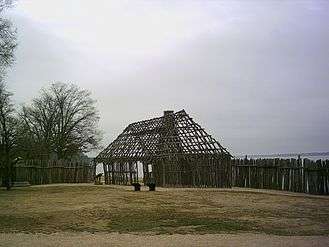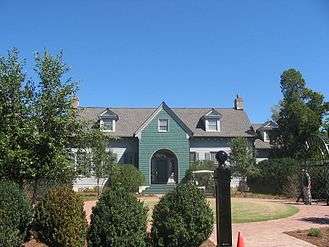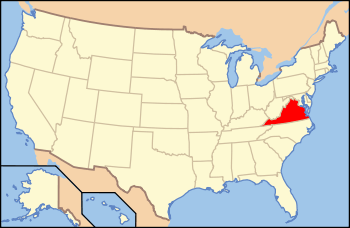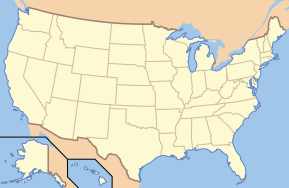Historic Jamestowne
| Jamestown National Historic Site | |
|---|---|
|
IUCN category V (protected landscape/seascape) | |
|
A statue of John Smith commemorating the site of the first permanent English settlement in America. | |
  | |
| Location | James City County, Virginia, United States |
| Nearest city | Jamestown, Virginia |
| Coordinates | 37°12′35″N 76°46′44″W / 37.20972°N 76.77889°WCoordinates: 37°12′35″N 76°46′44″W / 37.20972°N 76.77889°W |
| Area | 20.63 acres (8.35 ha) |
| Established | May 13, 1607 |
| Governing body |
Preservation Virginia (in partnership with NPS) |
| Website | Historic Jamestowne |
|
Jamestown National Historic Site | |
  | |
| Location | Jamestown Island, Jamestown, Virginia |
| Area | 20.6 acres (8.3 ha) |
| Built | 1607 |
| NRHP Reference # | 66000840[1] |
| VLR # | 047-0009 |
| Significant dates | |
| Added to NRHP | October 15, 1966 |
| Designated VLR | October 18, 1983[2] |
Historic Jamestowne is the cultural heritage site that was the location of the 1607 James Fort and the later 17th century city of Jamestown. It is located on the James River at Jamestown, Virginia and operated as a partnership between Preservation Virginia (formerly known as the Association for the Preservation of Virginia Antiquities) and the U.S. National Park Service.
The site was designated Jamestown National Historic Site on December 18, 1940, and listed on the National Register of Historic Places on October 15, 1966. It was also designated a National Historic Chemical Landmark in 2007 by the American Chemical Society.[3] It is adjacent and complementary with Jamestown Settlement, a living history museum built run by the Commonwealth of Virginia to interpret the early colony.
The mission of Historic Jamestowne is to "preserve, protect and promote the original site of the first permanent English settlement in North America and to tell the story of the role of the three cultures, European, North American and African, that came together to lay the foundation for a uniquely American form of democratic government, language, free enterprise and society."[4]
History
Jamestown, first established on May 13, 1607, was the site of the first permanent English[5] settlement in North America. Jamestown was the capital of the Virginia Colony, and saw Bacon's Rebellion in 1676, when the statehouse was burned. After a second burning in 1698, the capital was relocated to higher ground at Middle Plantation in 1699, which was then renamed Williamsburg.
By the middle of the 18th century, the land was cultivated mainly by the Travis and Ambler families. During the American Revolutionary War the area was used as a military post where American and British prisoners of war were exchanged.
In the 19th century, Jamestown Island reverted to little-used farmland, and in 1862 became the site of Doller's Point Battery, a Confederate earthworks during the American Civil War intended to protect Richmond against Union gunboats. Swann's Point Battery was a Union Army battery located Swann's Point above the mouth of Gray's Creek on the James River, opposite Jamestown Island from 1862-1865. The Ambler Farm was burned by escaped slaves, who found the desolate island to be a haven. The area then reverted to farmland until preservation efforts began at the end of the 19th century.
Preservation
By 1893, the site of Jamestown was owned by Mr and Mrs Edward Barney, who donated 22 1⁄2 acres (9.1 ha) of land, including the 17th-century tower of the Jamestown Church, to Preservation Virginia. By this time, erosion from the river had eaten away the island's western shore; visitors began to conclude that the site of James Fort lay completely underwater. With federal assistance, a seawall was constructed in 1900 to protect the area from further erosion.
In 1934, Colonial National Historical Park obtained the remaining 1,500-acre (610 ha) island and partnered with Preservation Virginia to preserve the area and present it to visitors in an educational manner. The site was designated Jamestown National Historic Site on December 18, 1940, and listed on the National Register of Historic Places on October 15, 1966.
In 1994, with the quadricentennial year approaching, Preservation Virginia agreed to fund a 10-year archaeological project called Jamestown Rediscovery to search for any remains of James Fort, led by Dr. William Kelso. By 1996, Jamestown Rediscovery archaeologists had found James Fort, which had only lost a western bulwark to river erosion. Excavations continuing on the site have uncovered evidence of the Starving Time winter of 1609/10, the arrival of the survivors from the Bermuda shipwreck "Sea Venture," and close to 1.5 million artifacts. The colonists' structures have been identified including temporary soldiers' shelters, row houses, wells, the storehouse, and the 1608 church. The original 10-year archaeological project has continued well past this period; current visitors to the site can see ongoing excavation efforts as they continue to unearth the original settlement's buildings and artifacts near the James Fort site and Jamestown Church. Several of the archaeologist teams' discovers have been named as the top 10 archaeology finds in various years by Archaeology, including evidence that the colonists had likely resorted to cannibalism during the "starving time" from finds in 2013,[6] and the discovery the original church built inside James Fort in 2010,[7] and subsequently the identification of four graves within it belonging to important Jamestown settlers in 2015.[8]
The National Park Service maintains the remaining portions of the island with recreations of building foundations of the post-1610 Jamestown port town.
In 2006, many preparations were underway for the Jamestown 2007 event celebrating the 400th anniversary of the settlement. Queen Elizabeth II visited Historic Jamestowne on May 4, 2007 — she had previously visited the park in October 1957. As noted by Queen Elizabeth during her state visit to the U.S. in 2007, Jamestowne was the beginning, not just of America, but of the British Empire.
The site was visited by several dignitaries, including President George W. Bush and Elizabeth II, Queen of the United Kingdom, to commemorate the 400th anniversary of the landing at Jamestown in 2007. The Nathalie P. and Alan M. Voorhees Archaearium museum onsite opened just prior to the 400th anniversary and displays objects that belonged to Jamestown colonists 400 years ago, unearthed from the long lost James Fort site in a 7,500 sq. foot gallery space integrating both life and death experiences of the colonists and the landscape they shaped. Additional archaeological materials from James Fort are featured in the Smithsonian Institution's limited exhibition, Written In Bone: Forensic Files of the 17th-Century Chesapeake from February 7, 2009 to January 6, 2013 at the National Museum of Natural History in Washington D.C.
Voorhees Archaearium
Officially named the Nathalie P. and Alan M. Voorhees Archaearium, the Voorhees Archaearium is a museum with excavated artifacts and exhibits about Jamestowne. The building is located over the excavated remains of the last Statehouse in Jamestown, which visitors can see.
Gallery
 Boardwalk and visitors' center at Historic Jamestowne
Boardwalk and visitors' center at Historic Jamestowne Reconstruction of the barracks at James Fort
Reconstruction of the barracks at James Fort Graves of settlers who died in 1607
Graves of settlers who died in 1607 Seawall along the James River
Seawall along the James River Archaearium and memorial to those buried beneath it
Archaearium and memorial to those buried beneath it Yeardley House, home to the Jamestown Rediscovery project's offices
Yeardley House, home to the Jamestown Rediscovery project's offices Historic Jamestowne seen from the James River Ferry
Historic Jamestowne seen from the James River Ferry- Jamestowne Tercentennial Monument near the historic settlement
 Glass house near the settlement
Glass house near the settlement Dig taking place at Jamestown
Dig taking place at Jamestown
See also
| Wikimedia Commons has media related to Historic Jamestowne. |
References
- ↑ National Park Service (2010-07-09). "National Register Information System". National Register of Historic Places. National Park Service.
- ↑ "Virginia Landmarks Register". Virginia Department of Historic Resources. Retrieved 5 June 2013.
- ↑ "National Historic Chemical Landmarks - American Chemical Society". American Chemical Society. Retrieved 2016-08-24.
- ↑ "About Us". Historic Jamestowne. Retrieved 13 June 2011.
- ↑ http://www.nps.gov/jame/learn/historyculture/a-short-history-of-jamestown.htm
- ↑
- ↑
- ↑
External links
- Preservation Virginia official website for Historic Jamestowne
- NPS official website for Historic Jamestowne
- Jamestown 2007 website
- Preservationvirginia.org: History of Jamestown
- Preservationvirginia.org: Satehouse Site and Early Burial Ground
- Historic American Buildings Survey (HABS) No. VA-25, "Architectural Remains, Unit B, Sub-units 89 & 97, Jamestown, James City County, VA"
- HABS No. VA-26, "Architectural Remains, Unit A, Sub-unit 39"
- HABS No. VA-27, "Architectural Remains, Unit B, Sub-units 59 & 73"
- HABS No. VA-28, "Architectural Remains, Unit B, Sub-unit 62"
- HABS No. VA-29, "Architectural Remains, Unit B, Sub-unit 86"
- HABS No. VA-30, "Architectural Remains, Unit B, Sub-unit 76"
- HABS No. VA-31, "Architectural Remains, Unit B, Sub-unit 101"
- HABS No. VA-445, "Architectural Remains, Unit B, Structure 112"
- HABS No. VA-470, "Architectural Remains, Project 194, Structure 115"
- HABS No. VA-471, "Architectural Remains, Project 194, Structure 117"
- HABS No. VA-472, "Architectural Remains, Project 103, Structure 123"
- HABS No. VA-473, "Architectural Remains, Project 103, Structure 125"
- Historic American Engineering Record (HAER) No. VA-116, "Jamestown Island Loop Road, Jamestown Island, Jamestown, James City County, VA"



